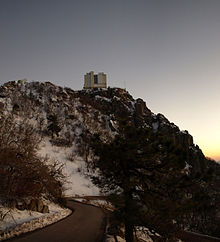- MMT Observatory
-
The MMT Observatory (MMTO) is an astronomical observatory on the site of Fred Lawrence Whipple Observatory (IAU observatory code 696). The Whipple observatory complex is located on Mount Hopkins, Arizona, USA (55 km south of Tucson) in the Santa Rita Mountains. The observatory is run by the University of Arizona and the Smithsonian Institution, and has a visitor center in nearby Amado, Arizona. The MMTO is the home of the MMT (formerly Multiple Mirror Telescope), which currently has a primary mirror 6.5 m in diameter. The name originally comes from the fact that the light gathering for the telescope was done by six smaller mirrors before the current primary mirror was installed. The current mirror is notable because it is of a special lightweight honeycomb design made by the University of Arizona's Steward Observatory Mirror Laboratory. The MMT is also notable because of its interesting building, which does not look in the least like the typical observatory dome. The building's unique shape is in order to completely roll back the walls and roof around the telescope, thus allowing it to cool down very quickly in order to improve the seeing.
Contents
Multiple Mirror Telescope (1979-1998)
The MMT operated between 1979 and 1998 with 6 mirrors, each with a diameter of 1.8 meters, providing the equivalent gathering area of a 4.5-meter telescope, making it the third largest optical telescope in the world at the time of its dedication. It featured ambitious design innovations including its unusual optical design proposed by Aden Meinel, a co-rotating building and an altitude-azimuth mount.
With the exception of the Bolshoi Teleskop Azimutalnyi (BTA-6) and William Herschel's 40-foot telescope, major optical telescopes prior to the MMT used equatorial mounts. The MMT heralded a change in telescope design; all major optical telescopes since the MMT have been built with alt-azimuth mounts. Several technologies pioneered at the MMT contributed to the success of the subsequent generation of large telescopes. These included: high dynamic-range servos for the alt-azimuth mount; highly accurate pointing that eliminated the need for sky charts; co-alignment and co-phasing of multiple telescopes; improvements to optical performance by attention to the thermal environment of the facility; contributions to vacuum coatings deposition, optics cleaning, and maintenance; and early experiments in co-phased adaptive optics.
MMT (1998-present)
One of the reasons for its original multiple mirror design was the difficulty of casting large mirrors. One solution to this problem was found by Roger Angel of Steward Observatory, of the University of Arizona, who cast mirrors with a honeycomb structure in the interior of a rotating oven. This made it possible to replace the six mirrors with a single 6.5-meter one. The original building and part of the structure could be reused. The new mirror was cast and polished in the Steward Observatory Mirror Laboratory at the University of Arizona. It was the first 6.5-meter mirror cast at SOML. The new MMT was rededicated on 20 May 2000. [1]
In late 2002, a novel deformable secondary mirror was added to the telescope. [2] While other adaptive optics designs do their corrections with additional mirrors, minimizing the number of warm surfaces in the light path produces better results in infrared wavelengths. The MMT AO system contributed to the design of the Large Binocular Telescope, which achieved record breaking Strehl ratios with its AO system in 2010.
From 2004 to 2010, approximately 8% of MMT observing time was made accessible to the entire astronomical community via the US National Science Foundation's Telescope System Instrumentation Program (TSIP), administered by the National Optical Astronomy Observatory (NOAO). [3]
See also
External links
- The MMT Observatory
- MMT adaptive optics home page
- Mount Hopkins Clear Sky Clock Forecast of observing conditions.
- Smithsonian Astrophysical Observatory (SAO)
- University of Arizona's Steward Observatory
Coordinates: 31°41′18″N 110°53′06″W / 31.68833°N 110.88500°W
Categories:- University of Arizona
- Astronomical observatories in Arizona
- Buildings and structures in Santa Cruz County, Arizona
- Fred Lawrence Whipple Observatory
Wikimedia Foundation. 2010.

